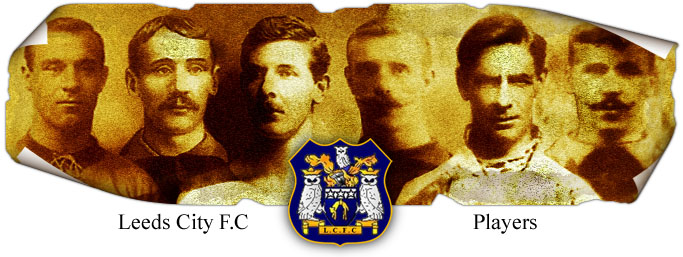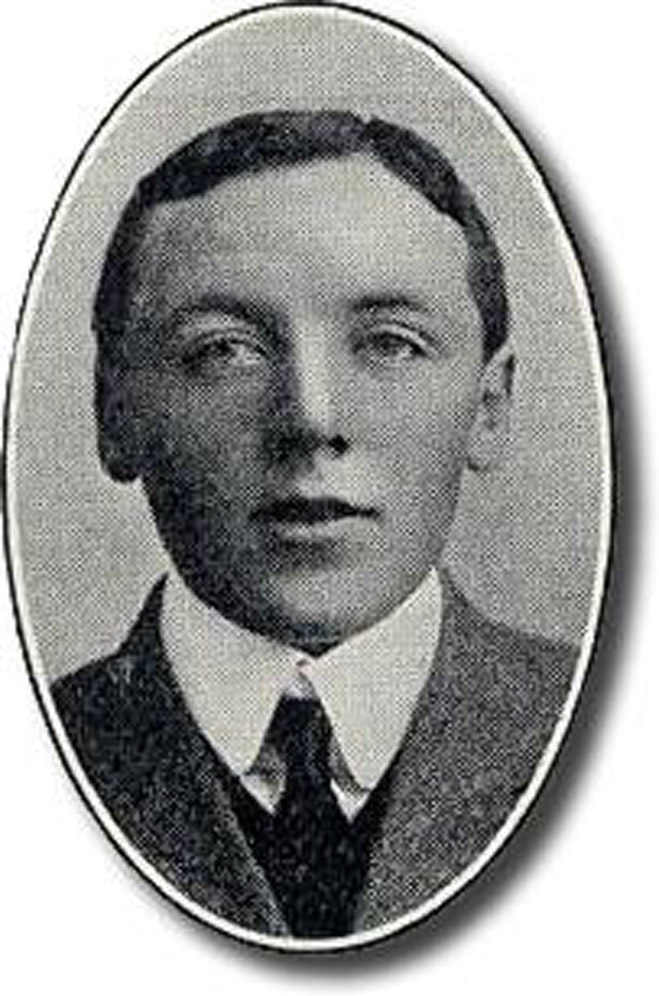| |


Kirk: Gerald
1906-1907 (Leeds City Player Details)
Centre Half
Born: Bramley, Leeds: 14-07-1883
Debut: v Hull City (a): 22-12-1906
Height & Weight: Unknown
Kirk, rather unusually for footballer playing at the national level for a northern club, came from a privileged background. His family were landowners in Ingleton,
Yorkshire. It was while he was attending Pocklington Grammar School as a boarder that his passion for football was ignited. In spite of the fact that the school placed
a greater emphasis on Rugby Union. Kirk went on to captain the local amateur side, Ingleton, and was part of the team that won the Lancaster and District League
championship in 1903. Kirk was still good enough at football to be signed by Second Division Bradford City. On 25th April 1905 Gerald joined Bradford City in the
Second Division, after impressing in a trial against Blackburn Rovers. Despite being offered a contract, he remained an amateur. Kirk made his debut first-team
appearance for the Bantams in a 2-0 victory over Blackpool at Valley Parade on 28th October 1905. He went on to become the club's established centre-half, making
forty League appearances, twenty-four in 1905-06, when City finished eleventh in the Second Division, and sixteen in the 1906-07 season when City improved to
become fifth and scored once in each season. He also took the field in the F.A. Cup in three games in the1905-06 season, in the 3-2 home win over Barrow, a 5-0
home win over Wolverhampton and the 0-1 loss to Everton at Goodison Park. He moved to Leeds City in the first-half of the 1906-07 seaon and made his debut on
22nd December 1906. He went on to play regularly and missed just one game subsequently as he completed eight League and one F.A. Cup fixtues. He played his
final game in a 0-4 defeat at Grimsby Town on 16th February 1907, as City finished tenth. His one Leeds goal came in the 2-2 draw at Leicester Fosse, when he
scored the second Leeds goal and his F.A. Cup appearance was in a 1-4 defeat ay Bristol City on 12th January 1907. He was at Leeds City until September 1907
when he returned to Bradford City and played three games in their championship of the Second Division 1907-08 season. Disheartened, Kirk decided to retire from
national football, though he was still only twenty-six years old. He scored two goals in forty League games and played three F.A. Cup games while at Valley Parade in
his first period with the club. He joined Second Division Leeds City in December 1906 and scored one goal in eight League appearances and played one F.A. Cup
tie while at Elland Road. He returned to Second Division Bradford City in September 1907 after losing his place at Elland Road but only played three League games
as the Bantams gained promotion and he never played professionally again after retiring at the end of the 1907-08 season, returning to play for his local team at
Ingleton. He enlisted in the King’s Own Lancashire Regiment at the outbreak of World War One and rose to the rank of Second Lieutenant before he was killed in action
at Ypres Belgium on 24th April 1915, aged Thirty-one, and he was buried in Poperinghe Old Military Cemetary.
The following is an extract from: The History of Bradford City - Fallen Heroes:
http://www.bantamspast.co.uk/earlydays/fallenheroes.html
At first glance, Gerald Kirk appears to be from a lost world of privilege and position. Son of a wealthy land-owning family, public school educated and a ‘gentleman’
amateur footballer. However, scratch the surface and you’ll find a man held in genuine esteem in his community and one who worked his way through the ranks to gain
a commission during the Great War. He was born in Headingley, Leeds, on 14th July 1883, son of Alfred and Isabella of Greenwood Leghe, of Ingleton, North Yorkshire.
From 1895 he attended, as a boarder, Pocklington Grammar School, East Yorkshire, where he played for the second XI at both football and cricket. Gerald appeared
at centre forward and inside left. He left the school in December 1900. Gerald’s family owned a great deal of property and land in the Ingleton area, presumably after
leaving school Gerald helped to manage the estate. In the 1901 census, the family are classed as ‘living on their own means’. A keen sportsman, Gerald captained
Ingleton Football Club. In April 1903 they won the Lancaster and District League Championship, the whole village wildly celebrated as the team returned home to a
heroes welcome. The following season they were beaten finalists in the Lancaster Senior Cup. Gerald joined Bradford City after impressing as a trialist in a friendly
against Dundee on 25th April 1905 and again in a friendly against Blackburn Rovers. He made his first team debut on 28th October 1905, when City defeated
Blackpool 2-1 in a Second Division game at Valley Parade. He established himself at centre-half and was a virtual ever-present thereafter. However, Gerald was
transferred to Leeds City in December 1906. At Elland Road he only played seven games – scoring one goal – before returning to Valley Parade in September 1907.
Back at Bradford City he was mainly a reserve, playing a mere three games during the 1907-08 season. City’s promotion to the top flight of English football brought
about fairly widespread changes in personnel and Gerald was one of many who left Valley Parade during the summer of 1908. In all, Gerald had played forty-three
games for City, scoring twice. Although Gerald was only approaching his Twenty-sixth birthday, he turned his back on ‘professional’ football and returned to his old club
Ingleton. Off the field of play Gerald was instrumental in forming Ingleton Conservative Club and was its first Honourable Secretary. Clearly an active citizen, he was also
on the board of the Ingleton National School. In line with his social standing he regularly hunted with the Vale of Lune Harriers. He married Sarah Jane Capstick at Holy
Trinity Church, Casterton, Westmoreland on 21 April 1909. They set up home at Hazel Mount, Warton near Carnforth. At the outbreak of the Great War the 1/5th battalion
King’s Own Lancaster Regiment moblised. The battalion was a territorial unit and it was found that two hundred soldiers were unfit for service. The local paper, the
Lancaster Observer, appealed for volunteers to fill the gaps in the ranks. On 1st September 1914 Gerald Kirk joined up and became one of what the paper called the
‘Gallant 200’. On his enlistment form Gerald gave his occupation as a ‘gentleman’. Despite his undoubted social status, Gerald initially served as a Private (service
number 2132), but was quickly marked out for promotion. He was duly promoted to Lance Corporal on 31st October 1914. Gerald’s Battalion were initially involved in
Home Defence duties around Lancaster and Barrow. From 14th August 1914 the battalion was used to guard the Great Western Railway line between Didcot and
Oxford. In November they left Didcot for Sevenoaks in Kent, where they combined with other troops from the Territorial West Lancashire Division. During that time
Gerald was offered a commission and eventually attained the rank of Second Lieutenant on 31st January 1915. In February 1915, they sailed for France and by 17th
February 1915 the first elements of the battalion began disembarking at Le Havre. They were one of the first Territorial units to be sent overseas. On 2nd March 1915
they were at Bailleul, prior to gaining their first experience of trench warfare at Neuve Eglise. They were relieved on 23rd March 1915 by the 1st Monmouthshire’s and
slowly marched away from the tumult of the front line for a period of well-earned rest in billets. All too soon, they moved to the infamous Ypres Salient and on 12th April
the battalion were in the front line trenches at Polygon Wood. In just five days they lost fourteen killed and forty-four wounded. The badly battered battalion moved to St
Jean and dug in as Ypres suffered from yet another spell of heavy shelling. On the afternoon of 22nd April 1915, the Germans launched the first gas attack in the history
\of warfare, at nearby St Julien. It descended on a portion of front held by French Colonial troops. Terrified by the strange yellow cloud enveloping them, the ‘Zouaves’
retreated in disarray. Gerald’s battalion watched as the retching and green-faced troops passed through their ranks. A Canadian Division somehow plugged the gap
and, though heavily outnumbered, checked the ensuing German advance. The following day Gerald’s platoon was ordered to support the Canadians, as part of a
hastily assembled counter attack. At 1pm they moved forward towards Pilkem and once again dug in. The attack commenced at 3.45pm and at 5pm Gerald’s battalion,
acting as reserve, joined the fray. With ‘C’ company leading, they immediately came under heavy machine gun and rifle fire from three sides. Suffering numerous
casualties they pulled back a couple of hundred yards. With no artillery support their position was almost hopeless. The Colonel in charge witnessed soldiers trying to
find cover wherever they could, some hid behind a pile of manure, but the bullets cut through and they were all killed. The Colonel made his way to Brigade HQ but was
simply told to ‘hold his position’. When he returned he found that ‘Kirk is seriously wounded’. The desperate assault blunted the German attack, but at great cost. Over
half the troops involved were killed. The battalion alone lost twenty-six killed, one hundred and two wounded and one gassed. Gerald, leading his platoon forward at
Wieltje, was shot through the chest. Badly wounded, he was taken to Poperinghe behind the lines. He died the next day, 24 April 1915, at Number 3 Casualty Clearing
Station, Poperinghe. Gerald is buried at Poperinghe Old Military Cemetary - plot 2, row K, grave 28.
| Appearances | Goals |
| League 8 | 1 |
| F.A. Cup 1 | 0 |
|